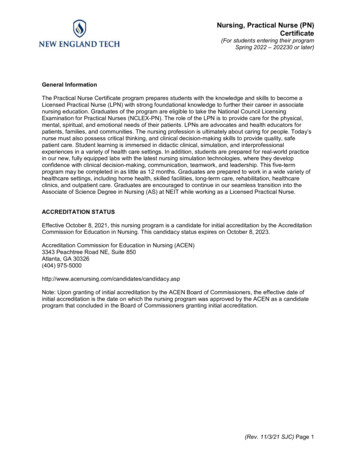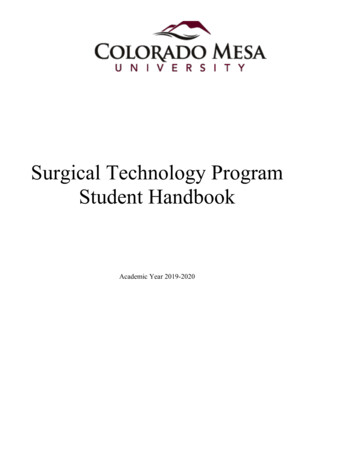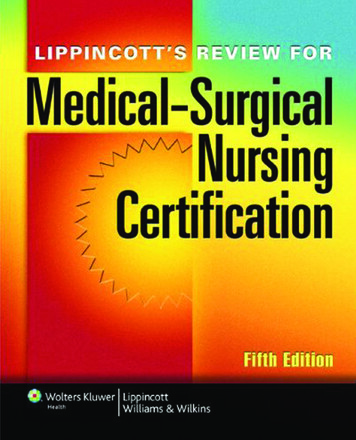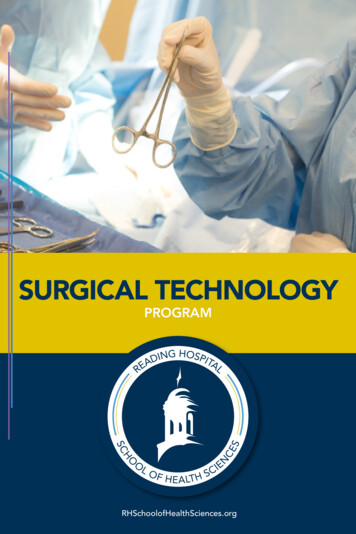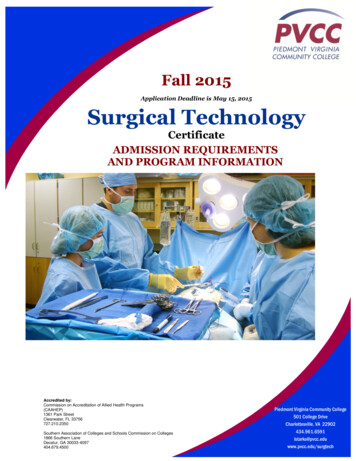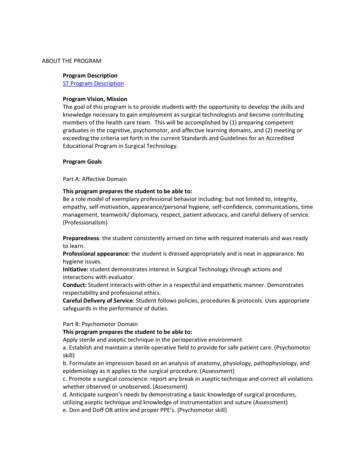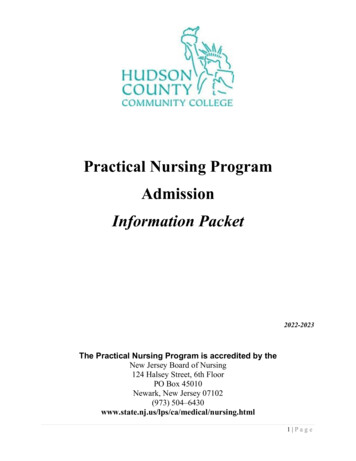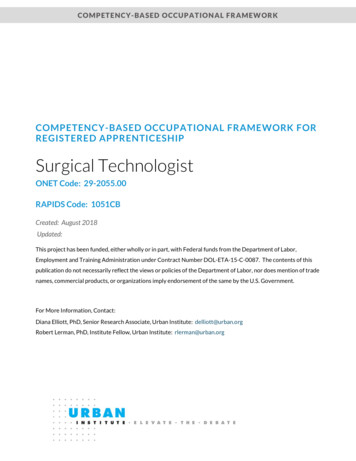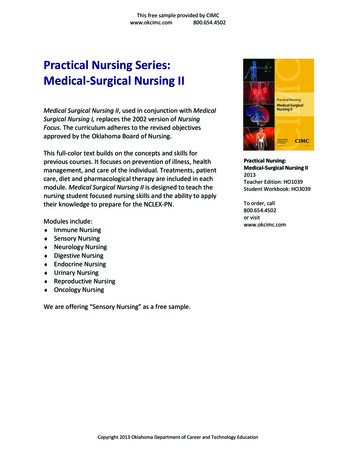
Transcription
This free sample provided by CIMCwww.okcimc.com800.654.4502Practical Nursing Series:Medical-Surgical Nursing IIMedical Surgical Nursing II, used in conjunction with MedicalSurgical Nursing I, replaces the 2002 version of NursingFocus. The curriculum adheres to the revised objectivesapproved by the Oklahoma Board of Nursing.This full-color text builds on the concepts and skills forprevious courses. It focuses on prevention of illness, healthmanagement, and care of the individual. Treatments, patientcare, diet and pharmacological therapy are included in eachmodule. Medical Surgical Nursing II is designed to teach thenursing student focused nursing skills and the ability to applytheir knowledge to prepare for the NCLEX-PN.Modules include: Immune Nursing Sensory Nursing Neurology Nursing Digestive Nursing Endocrine Nursing Urinary Nursing Reproductive Nursing Oncology NursingPractical Nursing:Medical-Surgical Nursing II2013Teacher Edition: HO1039Student Workbook: HO3039To order, call800.654.4502or visitwww.okcimc.comWe are offering “Sensory Nursing” as a free sample.Copyright 2013 Oklahoma Department of Career and Technology Education
IMPractical NursingMedical SurgicalNursing IITeacher O1039
MODULE 2s e n s o r y Nu r s i n gFree Sample Provided by CIMC800-654-4502okcimc.comThis module provides an understanding ofthe sensory organs and their functions,disorders that affect these organs, andtreatments of these disorders. The most common senses which display impairments are vision,hearing, taste and smell. Additionally, the sense oftouch, position and movement may be impaired.These senses are important for an individual’sinteractions with their environment and otherindividuals. Impairments of these senses must behandled appropriately and carefully by the nurse.Completion of this module should provide anunderstanding and knowledge of how to provideappropriate nursing care to individuals with sensory disorders and impairments.
iReview the LearningObjectives with thestudents. Look aheadto the Learning Activitiesin this module and plan tointroduce them.LEarning ObjEctivEs1. Explain the function of the sensory system.2. Distinguish among sensory disorders.3. Relate diagnostic tests and surgical procedures to the nursing care ofTeachingSUggestions A long with many helpfulwebsites, there are nowmany “apps” available tohelp students and nursesobtain needed information from their smartphones, tablet devices,etc. Search iTunes orother application databases for the most up-todate “apps” available foreach content area. See thefollowing links for possible apps related to thesensory system.patients with sensory disorders.4. Evaluate pharmacological effects of medications used to treat sensorydisorders.5. Contribute to the plan of care for patients experiencing alterations insensory or perceptual function.6. Distinguish among patient education needs related to self-care for sensorydisorders.Free Sample Provided by CIMC800-654-4502 S ensory appsokcimc.com B e sure to advise thestudents that these “apps”may cost to download. 3600865?mt 8 H earing /id398460048?mt 8 t 8CIMC MEDICAL SURGICAL NURSING II 109?mt 8 (amplifier) http://itunes.apple.com/app/id450577890— Continued on next pagemodule O v e r v i e wThis module provides concise information regarding sensory disorders including their symptoms and associated medications, diagnostic tests, and nursing care. Students should be encouraged to reacquaint themselveswith the sensory system information from their Anatomy and Physiology course.2CIMC MEDICAL SURGICAL NURSING II
L E a r n i n gO b j E c t i v EObj ecti v e Explain the function of the sensorysystem.The senses provide humans with the ability to interact with their environment through seeing, hearing,tasting, smelling, touching, and maintaining position and movement. These senses enable humans tosurvive because of the appropriate responses. Shouldthese responses not occur, or occur inappropriately,patients may be injured or suffer disorders of thesensory system. d411289776?mt 8The actual mechanics of vision take place within theretina, the optic nerve, and the brain. Photoreceptors,specialized cells that are sensitive to light and color,are the rods and cones of the retina. mt 8D i d You Know?Color blindness is caused by anabsence of one or more cones.Cones are sensitive to the colorsred, green, and blue.visiOnThe function of the eyeball is transformation of lightto nerve signals which are interpreted into visual images in the cerebral cortex of the brain. V isionSense of Vision 8414?mt 8Normal aging causes the eye to lose elasticity of thelens; this causes the muscles of the eye to be unableto accommodate (move the lens as needed) andpresbyopia (far sightedness due to aging) occurs.The lens may also become slightly opaque, causingdifficult vision when glare is present. Because thepupil becomes smaller with age, more light is neededto read. 9694?mt 8 F or iPadEye Glands 802332?mt 8(Eye chart)Lachrimal gland(Tear gland)Free Sample Provided by CIMC800-654-4502learningwwwlinkokcimc.comTear ductsTear esMODULE 2 SENSoRy NURSING stUDEnt EDitiOn3Teaching SUggestions Review the following information with the students. S tructure of the eyeA ccessories of the eyeI ntraocular anatomyP hysiology and function of the eyeM O D U L E 2 S e n s o r y N u r s i n g T E ACH E R E D I T I O N3
HEaringlearningwwwlinkThe ear consists of three sections, which work together to provide the sense of hearing. The outer earreceives the sound waves and propels them to the interior portions of the ear. The middle ear is small andcontains air and three bones. The three bones are themalleus (hammer), the incus (anvil), and the stapes(stirrup). The inner ear contains fluid-filled cavitiesand canals. It also contains the cochlea, semicircularcanals, and the vestibulocochlear nerve.Hearingwww.youtube.com/watch?v PeTriGTENoc&feature relatedMalleus(hammer)Incus(anvil)Important FactIt’s easy for a throat infection to spread to theears because it can travel up the Eustachiantubes into the middle ear. These structures are alllined with continuous mucous membrane.SemicircularcanalsAuditory nerveTo brainEar canalCochleaOval windowStapes(stirrup)TympanicmembraneFree Sample Provided by CIMC800-654-4502okcimc.comPinnaEustachian TubeD i d You Know?Cerumen is earwax that protectsthe ear by trapping foreignparticles and dust.44CIMC MEDICAL SURGICAL NURSING IICIMC MEDICAL SURGICAL NURSING II
Sense of Hearing The eardrum, or tympanic membrane, separatesthe outer ear from the middle ear. The eustachian tubes connect the middle earwith the nasopharynx. They function to equalize pressure on either side of the eardrum. Thisis why yawning or swallowing, which opens thetube and allows air to enter the middle ear, helps“pop” the ears when at high altitudes. Sound waves travel through the middle ear fromthe vibrating tympanic membrane causing themalleus to vibrate.The malleus movement triggers the incus tomove and transfer the sound waves to the stapes.The movement of the stapes transfers the soundwave to the oval window, which transfers thesound waves into the inner ear. The ossicles of the middle ear are the small bonesthat carry the sound waves; they are the malleus,incus, and stapes. The endolymph and perilymph conduct soundwaves from the middle ear through the inner ear. The organ of Corti transmits sound waves tothe brain through the hair cells. The inside ofthe organ contains many, many hair cells thatstimulate the cochlear nerve (part of the vestibular cochlear nerve, the eighth cranial nerve) inresponse to sound waves. The cochlear nerve then transmits the sound tothe brain for interpretation. The semicircular canals contain hair cells also.The movement of endolymph within the semicircular canals stimulates these hair cells. Themessage is sent to the brain, which interprets it tomaintain balance and equilibrium.Sources of damage to hair cells in the organ of Corti,causing permanent hearing loss, include: Jet engines Factory equipment Race car engines Loud amplifiers (music or drums) Wearing earphones with electronic equipmentturned to high ects/ViewObject.aspx?ID AP14104s E n s E s O f ta s t E a n DsMELLSmell and taste are two very closely related senses.These senses protect us from eating food that isspoiled or poisonous. Many of the toxins in poisonous plants have a bitter taste. Our tongues are mostsensitive to bitter tastes, and our brain interpretsthem as something to reject, thereby protecting thebody from possible tmlTaste and SmellThe location of the taste receptors are: Sweet receptors—tip of the tongue Sour receptors—sides of the tongue Salty receptors—tip of the tongue Bitter receptors—back of the tongueFree Sample Provided by CIMC800-654-4502okcimc.comNormal aging affects smell and taste by causing adecrease in the nerve receptors for smell and taste.Sweet and salty taste receptors are the most affected.Normal aging affects hearing by causing a decrease inthe ability to distinguish high frequencies of sound.This is thought to be due to declining function of thenerve fibers in the cochlear nerve and the cells of theorgan of Corti. The ability to distinguish consonantsounds in hearing also decreases for the same reasonsMODULE 2 SENSoRy NURSING stUDEnt EDitiOnM O D U L E 2 S e n s o r y N u r s i n g T E ACH E R E D I T I O N55
SourBitterSourSweetSaltyThe glossopharyngeal nerve transmits the messagesof taste to the brain. The olfactory receptors arelocated in the upper section of the nasal cavity. Thisis why people breathe deeply when smelling a flower.The olfactory nerve transmits the messages of smellto the brain.sEnsE Of tOUcHSensory receptors cover the skin and epithelia, skeletal muscles, bones and joints, internal organs, andthe cardiovascular system. The sense of touch reactsto diverse stimuli using different receptors: Thermoreceptors (temperature)Certain odors stimulate memories because thebrain stores the odor and the events associatedwith it in long-term memory. Nocireceptors (pain) Mechanoreceptors (pressure) When olfactory cells are damaged, the person’ssense of smell will be lost since the body cannotregenerate olfactory cells. Chemoreceptors (chemical) Food does not taste good when you have a coldbecause the sense of smell is impaired by nasalcongestion. When we cannot smell what we eat,some of the taste is lost. The senses of smell andtaste work together in our brain. Free Sample Provided by CIMC800-654-4502okcimc.com66CIMC MEDICAL SURGICAL NURSING IICIMC MEDICAL SURGICAL NURSING II
L E a r n i n gO b j E c t i v Edisorders.visUaL DisOrDErsMany eye conditions can affect a patient’s vision andunderstanding a patient’s vision impairment willallow the nurse to provide care that will meet thepatient’s needs. Refractory errors prevent light raysfrom converging into focus on the retina.learningwwwlinkD i d You Know?Obj ecti v e Distinguish among sensory Severe visual impairment is definedas the inability to read newspaperswith the use of corrective lenses. Total blindness is absence of lightperception and usable vision.Eye Health Slide Show— visual examples of eyedisorders Functional blindness occurs whenthere is some light perception butno usable ions-overviewRefractory ErrorsDisorderHyperopia FarsightednessMyopia NearsightednessPresbyopia Farsightednessdue to agingAstigmatismStructure AffectedPhysical FindingsCauses light rays to focus Blurred visionbehind the retinaCauses light rays to be focused in front of the retina The lens becomes lesselastic Decreases accommodative ability of the eye Irregularity of curve ofcornea Causes light rays tobend unequallyTreatment/NursingCareLasik Eye Procedures LASIK (laser-assistedin-situ keratomileusis) PRK (photorefractivekeratectomy) ICR’s (intra-cornealring segments) Refractive IOL (intraocular lens) implantation Phakic IOL’s Administer medications as directed byphysician Teach patient signsand symptoms ofinfection Patient will returnfor follow-up care asdirected Corrective lenses Contact .gov/medlineplus/ency/article/001020.htmFree Sample Provided by .htmPresbyopiawww.aoa.org/x4697.xmlMODULE 2 SENSoRy NURSING stUDEnt .nlm.nih.gov/medlineplus/ency/article/001015.htmM O D U L E 2 S e n s o r y N u r s i n g T E ACH E R E D I T I O N7
EyE injUriEslearninglinkwwwPenetrating Eye had.aspx?Category 349HordeolumEye injuries can result in permanent visual impairment. Causes of eye injury include trauma, throughauto accidents and sports injuries, or chemical exposure. The patient may experience pain, photophobia,redness, edema, tearing, blood present in chamber,abnormality in vision, abnormal intraocular pressure, or deficits in peripheral vision.to the eye occurs, first aid measures include havingthe victim lie down to prevent fluid from escaping from the eye. The penetrating object should bestabilized (a Styrofoam cup works well to cover theeye and the object), and the victim transported to anemergency department as soon as possible. Only aphysician should remove the penetrating object.Penetrating wounds to the eye can result in completeloss of vision and loss of the eye itself. It is importantfor the nurse to assess the size of the object that ispenetrating the eye and whether fluid is leaking fromthe eye. When vitreous humor, the jelly-like fluidthat gives the eyeball its shape, escapes from the eye,vision is usually lost. When a penetrating woundTo provide care for an eye injury, the nurse shouldcover the eye with a dry sterile patch and a protective shield, stabilize any foreign objects, elevate headof bed 45 degrees, avoid pressure on the eye, andinstruct patient not to blow their nose. In the caseof chemical exposure, the eye should be irrigated assoon as possible with sterile saline or water.Infections and Inflammation of the azionStructure AffectedPhysical FindingsHordeolum StyeSebaceous glands in theeyelid Red Swollen Tender areaChalazionSebaceous glands in theupper lid Swelling Tender ent/NursingCare Treatment consists ofapplication of warm,moist compresses fourtimes daily until healed Antibiotic ointment ordrops Warm, moist compresses If this treatment isnot effective, then anophthalmologist mayremove it surgically orinject it with corticosteroids Warm compresses Antibiotic eyedropsFree Sample Provided by zia-topic-overviewBlepharitisConjunctivitis(pink on of follicles of theeyelash along the rim ofthe eyelidInflammation of theconjunctiva caused by abacterial infectionInflammation of tmConjunctivitis8 ItchingBurningCrusting mucusRedness of the eyePainTearingItchingPain and discomfortPhotophobiaBlurred vision Antibiotic eyedrops Antibacterial, antifungal, and antiviral drugs Response to trauma Response to immunemediated reactions Replacement of vitamin A due to deficiencyCIMC MEDICAL SURGICAL NURSING m8CIMC MEDICAL SURGICAL NURSING II
Important FactlearningwwwlinkPink eye (conjunctivitis) is highly contagiousand can easily be spread to others. Reinfectionwithin a house or school can occur if preventativemeasures aren’t followed.These include: Hand washing Not sharing eye makeup Not sharing towels and handkerchiefs Changing pillowcases alth/cataract/cataract facts.aspConditions Affecting VisionDisorderCataractStructure AffectedPhysical FindingsOpacity of the lens, causing cloudiness Blurred vision/ photophobia Double vision Decreased night vision Increased nearsightedness Need for increased lightwith detailed work orreading The lens becomescloudy in appearanceOpen-angleIncreased intraocular pres- Decrease in peripheralGlaucoma (chronic) sure, causing damage tovision Occurs more graduallythe optic discand has mild yesmart/diseases/cataracts.cfmSurgical removal of cataractCataract SimulationTeach patient it is extremely critical to followtheir physician’s instructions following cataractsurgery for pen-Angle Glaucoma(Chronic) Photocoagulation isused to seal the leakingof serous fluid and bloodvessels in the region Medication Surgerywww.visionrx.com/library/enc/enc oaglaucoma.aspwww.glaucoma.org/glaucoFree Sample Provided by Postop care includes: Notify physician ifworsening pain is experienced Avoid strenuous activity Do not strain withstool or bend over Take a stool softenerMODULE 2 SENSoRy NURSING stUDEnt EDitiOnM O D U L E 2 S e n s o r y N u r s i n g T E ACH E R E D I T I O N99
Conditions Affecting Vision ContinuedlearningwwwlinkDisorderPhysical FindingsNarrow-angleGlaucoma (acute)Iris is too close to the canal Severe eye pain withthat drains aqueous humorcolored haloesand blocks it Blurry vision Nausea Comprises a medicalemergencyRetinal detachmentSeparation of retinal layers from the choroid RetinopathyRupture of aneurysms onretinal blood vesselsNarrow-Angle Glaucoma (Acute)www.youtube.com/watch?v gDfM3s7jxqMStructure al achment.htm MaculardegenerationScleral BucklingPhotoreceptors, bleedingof abnormal vessels nearmacula Treatment/NursingCare Treatment is aimed atdecreasing the intraocular pressure A laser is used to createopenings that allow theexcess fluid to escape Teach patient properafter-surgery care andmedication usageFlashes of light with Laser surgery is oftenused to repair the retifloatersPossible complete lossnal tearof vision Scleral buckling More invasive repair Reinforce instructionsregarding the need towear eye patches and/or eye shields aftersurgery Explain that light sensitivity is common forseveral weeks post-opSymptoms occur later The best treatmentand include blurredis prevention, whichvisioninvolves managementMissing areas in visionof diabetes and/orAbnormal spots or lineshypertensionin vision PhotocoagulationInability to see colors or Laser therapy is effective if initiated early indetailsprogression of disorderBlurry visionFree Sample Provided by al-detachment Straight lines appearing Photocoagulationwavy Loss of central visionwith intact peripheralvisionwatch?v YftCbXIw11kNursing Care forPatient Having s/737/755395/eye surgery.pdf Important FactThe most common cause of loss of vision fromaging is macular degeneration.10CIMC MEDICAL SURGICAL NURSING IIRetinopathyAmsler Grid to Check for Macular abetic athy.aspMacular md www.macular.org/1 blindness.html10CIMC MEDICAL SURGICAL NURSING II
strabisMUsaUDitOry DisOrDErsStrabismus (crossed eyes) occurs when the eyemuscles are weak in one or both eyes. This muscleweakness may occur because of muscle imbalance,muscle paralysis, or a congenital condition. Oftenthe good eye is patched for six to eight weeksto strengthen the muscles of the affected eye.Sometimes glasses may be prescribed as well aseye exercises. In some cases, surgery is indicated tostraighten the deviated eye.There are two different types of hearing loss attributedto problems with the ear. Sensorineural hearing loss isdue to dysfunction of the auditory nerve. When thehearing loss is caused by problems with sound transmission through the ear it is conductive hearing loss.D i d You Know?Intraocular pressure is thepressure within the eye andCauses of Hearing LossConductive:Strabismus Obstruction by cerumen (earwax) Scarring of tympanic membrane (repeated otitismedia)www.pedseye.com/strabismus adult strabismus.htm Congenital ural:is determined by the amount Ototoxic drugsof aqueous humor present. Repeated exposure to loud noise History of mumps, measles, meningitis, orMeniere’s disease Acoustic neuromaQ: How would you communicate differently with apatient with severely impaired ency/article/001004.htmDeaf CommunicationTechnologiesQ: How would you communicate with a patientwith severe hearing loss?www.assistech.com/deafcommunication.htmCauses of Hearing LossDisorderOtotoxicityStructure AffectedPhysical glosshelp.com/Free Sample Provided by CIMCarticles/ototoxicupheaval.htm (Part toxicaudiology.okcimc.comhtm (Part 2)Damage to the inner ear Problems with hearing Determine cause suchas the use of ototoxicor vestibulocochlear nerveand/or balancedrugsfrom certain drugs Permanent or temporary Ototoxicity- ringing in Instruct patients toreport hearing loss,the ears and a decreasein hearing abilityproblems with balance Low urine output Warn patients about theuse of aspirin and othermedications, which canDrugs causing conditioncause conditioninclude: Antibiotics Monitor urine output Antineoplastics Loop diuretics Non-steroidal antiinflammatory drugsMODULE 2 SENSoRy NURSING stUDEnt EDitiOn11CRI TICA L T HIN K ING q ue s ti on a ns wersQ: How would you communicate differently with a patient with severely impaired vision?Answer: How a nurse communicates with a person with severe vision impairment may depend on whetherthere are other concurrent health issues. See the links below for information on this topic. Vision impaired:www.afb.org/Section.asp?SectionID 36&TopicID 163&DocumentID 194Q: How would you communicate with a patient with severe hearing loss?Answer: Several tips for communicating with people who have severe hearing loss can be found at: www.michdhh.org/hearing/comm tips.htmlM O D U L E 2 S e n s o r y N u r s i n g T E ACH E R E D I T I O N11
Causes of Hearing Loss ContinuedlearningwwwlinkDisorderMeniere’s diseaseMeniere’s mlwww.medicinenet.com/meniere disease/article.htmOtitis tmImage of TympanicMembrane with andwithout OMStructure AffectedIncreased fluid in thelabyrinth spaces, causingswelling of the membranesof the cochleaPhysical Findings Treatment/NursingCareHearing lossVertigoLoss of balanceDizzinessNausea Treatment includesdrugs such as: Atropine Epinephrine ValiumIncreased pressure in the Antihistaminesinner ear, causing damage Antiemeticsto structures Anticholinergics Vasodilators Diuretics Surgical removal of theendolymph sac Assess and documentsymptoms and frequency Instruct patient onsafety precautions during acute attacks Assist patient to determine if they experience an aura and whatactions to take shouldit occur Instruct patient to restin dark, quiet room Tell patient to avoid: Caffeine Decongestants Stimuli that cause attacks such as brightlights or noisy places Bending over withhead down A low-sodium dietand diuretics may helpreduce excess fluidInfection of the middle ear Occurs after a respira Antibiotics, antihistafrom bacteria or virusestory infection and causesmines, and/or deconfluid to build upgestants Pain in infected ear, Incision may be madefeverinto the eardrum and a Feeling of fullness intube inserted to drainthe earthe fluid and equalize Impairment in hearingpressure Redness and bulging of Administer pain medsthe tympanic membraneas neededFree Sample Provided by nt/otitis media.htmOtitis media12CIMC MEDICAL SURGICAL NURSING IITeaching SUggestions R emind students that when a patient experiences hearing loss while on a medication known to cause ototoxicity, it isn’t necessarily ototoxicity. The nurse should always assess if the patient has had prior hearingloss or if the hearing loss they are experiencing is different from what they normally experience.12CIMC MEDICAL SURGICAL NURSING II
Causes of Hearing Loss ContinuedDisorderStructure AffectedOtosclerosisPhysical s the bones of the Difficulty hearing exter- Hearing aidmiddle ear, causing the stanal sounds Surgical procedurepes to become fixed so it The sound of patient’scalled a stapedectomy,cannot vibrate or produceown voice becomesor a tympanoplastysound waveslouder Provide HealthInformation/otosclerosis.cfmOtHEr sEnsOryi M pa i r M E n t sOther sensory impairments can be problematic tothe patient. If a patient is unable to smell or tastefood, they may become malnourished. The sense ofsmell and taste work together to make the diningexperience more appealing.Otosclerosis tapedectomy.htmlOther Sensory ImpairmentsDisorderStructure AffectedDysgeusiaHyposomiaTaste budsPhysical Findings Foul, salty, rancid, ormetallic taste sensation will persist in themouth Burning mouth syndrome, a condition inwhich a person experiences a painful burningsensation in the mouthTreatment/NursingCareLoss of Taste Sensation— Dysgeusia Determine cause suchas smoking, flu, medications Prepare foods with avariety of colors andtextures Use spices Add foods that havebutter, olive oil andother forms of fat Avoid dishes that havea combination of ingredients Assess to determine ifcondition is related to aging or other conditions Determine if medications could be possiblecause Support treatment ofunderlying cause suchas flu, cold, infection,nasal swelling Recommend patient stopsmoking if applicable Tell patient to check forspoilage of foodswww.medicinenet.com/loss of taste sensation/symptoms.htmFree Sample Provided by CIMC800-654-4502okcimc.comDiminished sense of smellPresbyosomia – lossof smell due to aging Total or partial loss ofsmell Think they smell badodors Headaches, dizziness,shortness of breath, oranxietyMODULE 2 SENSoRy NURSING stUDEnt EDitiOnM O D U L E 2 S e n s o r y N u r s i n g T E ACH E R E D I T I O N1313
Other Sensory Impairments ContinuedlearningwwwlinkDisorderStructure AffectedSensory integration Inability to integrate cerdisorder or dysfunc- tain information receivedtion (SID)from the body’s basicsensory systemsSensory IntegrationDisorder (SID)www.sinetwork.org/www.youtube.com/watch?v 6O6Cm0WxEZABenign ParoxysmalPositional nign paroxysmalpositional vertigoInner earMovement ent disorders Disruption of any portionof nervous system cancause a person to produceundesirable movementPhysical Findings Over-sensitivity totouch, movement,sights, or sounds Under-reactivity totouch, movement,sights, or sounds Easily distracted Activity level that is unusually high or unusually low Physical clumsiness orapparent carelessness Impulsivity or lack ofself-control Difficulty in makingtransitions from onesituation to another Inability to unwind orcalm self Dizziness Unsteady gait/balance Frequent falls Labyrinth becomesinfected or swollen Small calcium stones inthe inner ear becomedisplaced Fluid in the inner ear Dystonia Tremor Tics Akathisia – restless legsyndrome (a desire tomove to relieve uncomfortable sensations) Rigidity Postural instabilityTreatment/NursingCare Therapeutic bodybrushing to overridestimulation TENS units Music therapy Biofeedback Teach exercises Assess to determinecause and remove causative agent Administer antibioticsas ordered Assist ambulation asneeded Assist with physicaltherapy as directed Teach medication use Provide perioperativecareFree Sample Provided by CIMCwww.wemove.org/800-654-4502okcimc.com1414CIMC MEDICAL SURGICAL NURSING IICIMC MEDICAL SURGICAL NURSING II
L E a r n i n gO b j E c t i
Medical-Surgical Nursing II 2013 Teacher Edition: HO1039 Student Workbook: HO3039 To order, call their knowledge to prepare for the NCLEX 800.654.4502 or visit www.okcimc.com Sensory Nursing Practical Nursing Series: Medical-Surgical Nursing II This free sample provided by CIMC www.okcimc.com 800.654.4502
